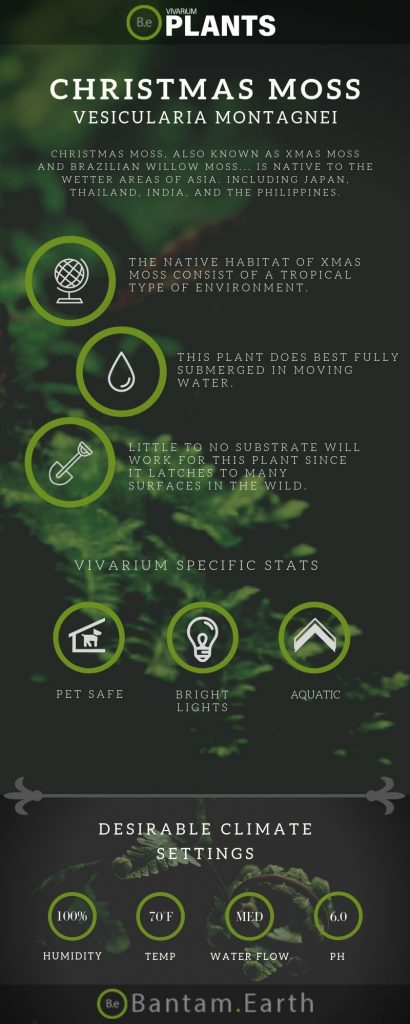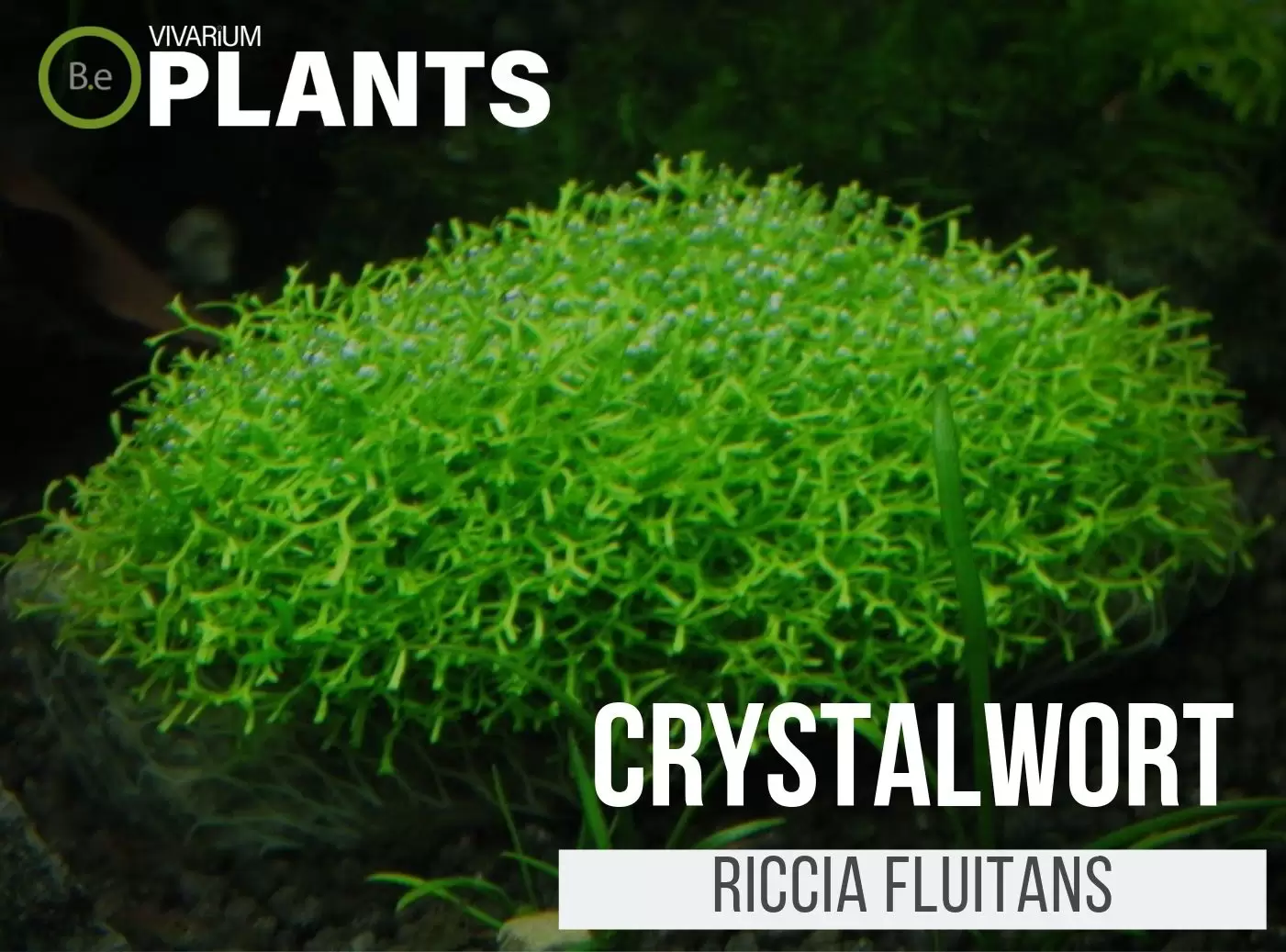Christmas moss is one of the most widely used mosses in aquarium husbandry.
Although it is not very fast-growing, it makes for some amazing carpet moss when used as an aquarium plant in freshwater aquariums.
Christmas moss got its name due to its attractive look.
These plants’ branches hang down, overlap each other, and have the shape of a Christmas tree.
This moss is considered to be an intermediate-level plant when it comes to care and cultivation.
| Quick Stats: | |
|---|---|
| Scientific Name | Vesicularia montagnei |
| Common Name | Christmas moss, Xmas moss, Brazilian willow moss |
| Family Name | Fissidentaceae |
| Habitat | Freshwater |
| Temperature | 65°F to 77°F |
| Height | 4 inches |
| pH | 6.0 to 7.5 |
| Lighting | Medium to bright |
What Is Christmas Moss?
The scientific name for Christmas moss is Vesicularia montagnei. It belongs to the Hypnaceae family under the order Hypnales of class Bryopsida.
Vesicularia montagnei is an aquatic moss and does exceptionally well completely submerged in water.
Aside from its aesthetic qualities, it also serves as a great hiding spot and food source for small animals in the tank.


Christmas Moss Facts
Besides Christmas moss, Vesicularia montagnei is also referred to as Xmas moss. In Japan, it is commonly referred to as Brazilian Willow Moss.
Due to its feathered growth and appearance, it is often confused with its sibling Java moss.
Even though they do share similar characteristics, these are two completely different plants.
Description
Despite its striking resemblance to a fir tree, Christmas moss is a creeping type of plant that grows horizontally rather than vertically.
It is usually not a very fast grower but can manage to get pretty wide as long as it’s unobstructed.
This is why most hobbyists tend to use it as a carpet or moss wall throughout their tanks.
Christmas moss leaves are round or oval in shape and come to a short point.
They tend to be very small in size, about 1.5 mm in length, and grow at a right angle from the stem.
Habitat
Christmas moss is native to the tropical areas of Asia. It can be found all throughout Japan, Thailand, India, and the Philippines.
This moss is usually found submerged underwater on shaded riverbanks, creeks, and streams.
Christmas moss can be seen naturally attached to rocks, branches, drowned tree boles, or simply floating around.
Just like most other mosses, it has a rhizoid root-like system, which means it consumes nutrients through its leaves and stems.
Vesicularia montagnei prefers cooler flowing water that ranges anywhere from 65 to 77 degrees Fahrenheit.
PH Preference
Christmas moss is a freshwater plant and will not survive in saltwater. It prefers fairly soft water with a pH level between 5 and 7.5.
The pH level of the water is also an important factor to keep in mind. This plant can handle both lightly basic and neutral water.
Vivarium Type
This type of moss will do great in a variety of vivarium types. When deciding if rather or not to use this moss in a particular type of enclosure, be sure to go with setups that have aquatic features.
Here are recommended vivarium Phoenix moss will do well in:
- Paludarium – Half aquatic/ half terrain-based enclosure.
- Riparium – Mostly aquatic-based enclosures with some terrain features present.
- Aquarium – Fully aquatic-based enclosures with little to no dry terrain.
Vivarium Placement
Christmas moss is an aquatic-based plant and should be placed underwater.
It can technically be placed anywhere in an aquarium and thrive.
However, it should usually be planted in the bottom, back, or side of a tank to create a carpet/wall.
The moss can be attached to a mesh-like material using a fishing line until it begins to grow and take on the desired shape.
Christmas moss can also be attached to driftwood, stones, or tree roots to enhance the aqua-scaping of any aquarium.
If left to grow unattached or free float it will grow a bit wilder and resemble Java moss.
Substrate
Due to its shallow root structure and unique way of absorbing nutrients, Christmas moss can grow pretty much anywhere.
It does not necessarily need any specific substrate to be able to survive.
As long as there is a stream of clean water, this moss will find a way to thrive.
As mentioned before, in the wild it can mostly be seen growing on rocks, branches, tree trunks, or floating around.
Lighting
Vesicularia montagnei is quite impressive moss that can survive in almost all lighting conditions.
However, its growth rate will definitely be affected by the amount of light this plant receives.
Low to medium light will work but will slow the moss’s rate of growth.
Christmas moss ideally prefers brighter lights as long as it’s not direct sunlight for long periods of time.
Buy Christmas Moss
When shopping for possible Christmas moss for sale, expect a few key indicators you are buying the best quality plant.
The moss should be snail free along with any other type of pest. The source of moss will usually be sold in small tissue cultures, ready for you to propagate.
The batch should arrive fairly moist and in fairly good shape. Click the image below to find out more about the current price and other relative info:




Christmas Moss Care and Propagation
When it comes to care and propagation, Christmas moss is considered by many to be an intermediate-level moss but not a very complicated plant.
As long as there is good water quality and flow it should do just fine. Stagnant or dirty water will not be suitable for this moss and most likely cause it to die out.
Although it is not particularly needed a liquid fertilizer and CO2 can be added to the water.
This should accelerate the growth rate as well as promote its health. Just like other mosses, a common complication with Christmas moss is algae.
Algae can be extremely difficult if not impossible to remove once it has begun growing on the plant.
Keeping a good flow and proper water changes should help keep it from developing altogether.
How to grow
The quickest and easiest way to reproduce Christmas moss will be through division. The original or parent moss should be taken and cut into separate and smaller pieces.
Then, simply attach the new pieces to their new location using a fishing line or cotton threads.
After a few weeks, the new pieces of moss should attach themselves using their rhizoids and begin to grow.
To promote further growth and maintain the desired shape, the moss should be periodically trimmed.
A good clean-up crew, such as Cherry Shrimp, should also help in keeping Christmas moss clean and healthy.
Watering
Since Christmas moss is usually fully submerged, it will not need to be watered. The plant will absorb all the water and nutrients it needs naturally.
An important factor to keep in mind is that Christmas moss is a freshwater plant.
High levels of salinity will be catastrophic and kill the plant within a couple of days. Aside from that, keeping a steady water flow free of debris and algae will also be crucial to its progress.
Plants Similar To Christmas Moss
Adding diversity to an enclosure is key to an aesthetically pleasing enclosure. Try mixing up the look of your vivarium with different flora that can easily co-exist in the same environment.
Furthermore, if for some reason you find this moss hard to acquire or would like to consider something similar to this plant…
Here are some other plants you might find may do well with or in the place of Vesicularia montagnei:
Conclusion
If you want something to accentuate and decorate your tank, Christmas moss might just be what you need.
It’s vivid green color and full look can help dress up or cover any undesirable areas or equipment that can be seen.
However, this is an intermediate-level aquarium moss and will require just a tad bit more attention than some of its counterparts.
I definitely wouldn’t recommend this moss for anything above the water line, keep this plant reserved for aquarium-type builds. Christmas moss is better suited for an enclosure that consists of mostly aquatic features.
Frequently Asked Questions
Yes, Christmas Moss is very easy to grow and maintain. It requires minimal light and fertilizer and can survive in a wide range of water parameters, making it suitable for any aquarium. In addition, it doesn‘t require frequent trimming and can easily be attached to rocks or driftwood with fishing line or a rubber band.
Yes, Christmas Moss (Vesicularia montagnei) requires some light to survive and thrive. It can be placed in low to moderate lighting conditions and is capable of utilizing some of the lower intensities of light, as opposed to more demanding aquatic mosses. It is recommended to place the Christmas Moss in an area of the aquarium that receives lights for 6–12 hours per day.
The main difference between Christmas Moss and Java Moss is that Christmas Moss grows in bushy, branches tendrils, while Java Moss has a more sheet–like growth pattern. Christmas Moss has more colorful leaves, ranging in hues of green, brown, and red, while Java Moss has more of a greenish–brown hue. Additionally, Christmas Moss requires more light than Java Moss and the care requirements are more demanding.
Yes, Christmas Moss (Vesicularia montagnei) needs to be submerged in water to survive and thrive. It requires good water quality, stable water temperature, and strong water flow to remain healthy.
No, Christmas Moss (Vesicularia montagnei) does not need to be attached. It can grow free floating on its own. However, it usually grows best attached to driftwood, rocks, or even a building material like an aquarium background or mesh.




Comments are closed.